Nano-Fibrillated Bacterial Cellulose Nanofiber Surface Modification with EDTA for the Effective Removal of Heavy Metal Ions in Aqueous Solutions
Abstract
1. Introduction
2. Results and Discussion
2.1. Preparation of EDNFBC
2.2. Structural Characterization of EDNFBC
2.2.1. FTIR Spectroscopy
2.2.2. XRD
2.3. Morphologies of EDNFBC
2.4. Adsorption Properties of Metal Ions
2.4.1. Effect of pH on Adsorption
2.4.2. Adsorption Kinetics
2.4.3. Adsorption Isotherms
2.4.4. Adsorption for Various Metal Ions
2.5. Reusability
3. Conclusions
Supplementary Materials
Author Contributions
Funding
Institutional Review Board Statement
Informed Consent Statement
Data Availability Statement
Acknowledgments
Conflicts of Interest
References
- Jahan, K.; Thankachan, D.; Shakya, K.; Mehrotra, N.; C.S., N.; Verma, V. Removal of heavy metal ions (Pb2+, Cu2+, Cr3+, and Cd2+) from multimetal simulated wastewater using 3-aminopropyl triethoxysilane grafted agar porous cryogel. Int. J. Biol. Macromol. 2024, 282, 136784. [Google Scholar] [CrossRef] [PubMed]
- Buema, G.; Trifas, L.M.; Harja, M. Removal of toxic copper ion from aqueous media by adsorption on fly ash-derived zeolites: Kinetic and equilibrium studies. Polymers 2021, 13, 3468. [Google Scholar] [CrossRef] [PubMed]
- Ghahremani, A.; Manteghian, M.; Kazemzadeh, H. Removing lead from aqueous solution by activated carbon nanoparticle impregnated on lightweight expanded clay aggregate. J. Environ. Chem. Eng. 2021, 9, 104478. [Google Scholar] [CrossRef]
- Pyrzynska, K. Removal of cadmium from wastewaters with low-cost adsorbents. J. Environ. Chem. Eng. 2019, 7, 102795. [Google Scholar] [CrossRef]
- Fei, Y.; Hu, Y.H. Recent progress in removal of heavy metals from wastewater: A comprehensive review. Chemosphere 2023, 335, 139077. [Google Scholar] [CrossRef]
- Lin, G.; Zeng, B.; Li, J.; Wang, Z.; Wang, S.; Hu, T.; Zhang, L. A systematic review of metal organic frameworks materials for heavy metal removal: Synthesis, applications and mechanism. Chem. Eng. J. 2023, 460, 141710. [Google Scholar] [CrossRef]
- Fu, F.; Wang, Q. Removal of heavy metal ions from wastewaters: A review. J. Environ. Manag. 2011, 92, 407–418. [Google Scholar] [CrossRef]
- Khanzada, A.K.; Al-Hazmi, H.E.; Kurniawan, T.A.; Majtacz, J.; Piechota, G.; Kumar, G.; Ezzati, P.; Saeb, M.R.; Rabiee, N.; Karimi-Maleh, H.; et al. Hydrochar as a Bio-Based Adsorbent for Heavy Metals Removal: A Review of Production Processes, Adsorption Mechanisms, Kinetic Models, Regeneration and Reusability. Sci. Total Environ. 2024, 945, 173972. [Google Scholar] [CrossRef]
- Shahrashoub, M.; Bakhtiari, S. The efficiency of activated carbon/magnetite nanoparticles composites in copper removal: Industrial waste recovery, green synthesis, characterization, and adsorption-desorption studies. Microporous Mesoporous Mater. 2021, 311, 110692. [Google Scholar] [CrossRef]
- Zhang, Y.; Zhang, C.; Wang, Y. Recent progress in cellulose-based electrospun nanofibers as multifunctional materials. Nanoscale Adv. 2021, 3, 6040–6047. [Google Scholar] [CrossRef] [PubMed]
- Khan, M.A.; Li, M.C.; Lv, K.; Sun, J.; Liu, C.; Liu, X.; Shen, H.; Dai, L.; Lalji, S.M. Cellulose derivatives as environmentally friendly additives in water-based drilling fluids: A review. Carbohydr. Polym. 2024, 342, 122355. [Google Scholar] [CrossRef] [PubMed]
- Kose, R.; Sunagawa, N.; Yoshida, M.; Tajima, K. One-step production of nanofibrillated bacterial cellulose (NFBC) from waste glycerol using Gluconacetobacter intermedius NEDO-01. Cellulose 2013, 20, 2971–2979. [Google Scholar] [CrossRef]
- Tajima, K.; Kusumoto, R.; Kose, R.; Kono, H.; Matsushima, T.; Isono, T.; Yamamoto, T.; Satoh, T. One-step production of amphiphilic nanofibrillated cellulose using a cellulose-producing bacterium. Biomacromolecules 2017, 18, 3432–3438. [Google Scholar] [CrossRef]
- Tsujisaki, H.; Hosokawa, M.; Takasaki, Y.; Yamagata, Y.; Kawabata, Y.; Tatumi, D.; Seno, S.; Miyamoto, K.; Isono, T.; Yamamoto, T.; et al. Detailed structural analyses and viscoelastic properties of nano-fibrillated bacterial celluloses. Carbohydr. Polym. Technol. Appl. 2024, 8, 100565. [Google Scholar] [CrossRef]
- d’Halluin, M.; Rull-Barrull, J.; Bretel, G.; Labrugère, C.; Le Grognec, E.; Felpin, F.X. Chemically modified cellulose filter paper for heavy metal remediation in water. ACS Sustain. Chem. Eng. 2017, 5, 1965–1973. [Google Scholar] [CrossRef]
- Osvaldo, K.J.; Leandro, V.A.G.; Rossimiriam, P.F.; Laurent, F.G. Adsorption of Cu(II), Cd(II), and Pb(II) from aqueous single metal solutions by mercerized cellulose and mercerized sugarcane bagasse chemically modified with EDTA dianhydride (EDTAD). Carbohydr. Polym. 2009, 77, 643–650. [Google Scholar] [CrossRef]
- Daochalermwong, A.; Chanka, N.; Songsrirote, K.; Dittanet, P.; Niamnuy, C.; Seubsai, A. Removal of heavy metal ions using modified celluloses prepared from pineapple leaf fiber. ACS Omega 2020, 5, 5285–5296. [Google Scholar] [CrossRef] [PubMed]
- Stachurski, C.D.; Larm, N.E.; Gulbrandson, A.J.; Trulove, P.C.; Durkin, D.P. Fiber welded EDTA-modified cellulose for remediation of heavy metal ions. Carbohydr. Polym. Technol. Appl. 2024, 7, 100504. [Google Scholar] [CrossRef]
- Elmaghraby, N.A.; Omer, A.M.; Kenawy, E.R.; Gaber, M.; Hassaan, M.A.; Ragab, S.; Hossain, I.; El Nemr, A. Electrospun cellulose acetate/activated carbon composite modified by EDTA (rC/AC-EDTA) for efficient methylene blue dye removal. Sci. Rep. 2023, 13, 9919. [Google Scholar] [CrossRef]
- Gusmao, K.A.G.; Gurgel, L.V.A.; Melo, T.M.S.; Gil, L.F. Adsorption studies of methylene blue and gentian violet on sugarcane bagasse modified with EDTA dianhydride (EDTAD) in aqueous solutions: Kinetic and equilibrium aspects. J. Environ. Manag. 2013, 118, 135–143. [Google Scholar] [CrossRef]
- André, M.S.; Kátia, M.N.; Vagner, R.B. Synthesis and characterization of hydrogels from cellulose acetate by esterification crosslinking with EDTA dianhydride. Carbohydr. Polym. 2014, 114, 260–268. [Google Scholar] [CrossRef]
- Rostami, N.; Dekamin, M.G.; Valiey, E.; Fanimoghadam, H. Chitosan-EDTA-Cellulose Network as a Green, Recyclable and Multifunctional Biopolymeric Organocatalyst for the One-pot Synthesis of 2-Amino-4H-pyran Derivatives. Sci. Rep. 2022, 12, 8642. [Google Scholar] [CrossRef] [PubMed]
- Fujita, S.; Sakairi, N. Water soluble EDTA-linked chitosan as a zwitterionic flocculant for pH sensitive removal of Cu(ii) ion. RSC Adv. 2016, 6, 10385–10392. [Google Scholar] [CrossRef]
- Soni, B.; Mahmoud, B. Chemical isolation and characterization of different cellulose nanofibers from cotton stalks. Carbohydr. Polym. 2015, 134, 581–589. [Google Scholar] [CrossRef]
- Pettignano, A.; Charlot, A.; Fleury, E. Solvent-free synthesis of amidated carboxymethyl cellulose derivatives: Effect on the thermal properties. Polymers 2019, 11, 1227. [Google Scholar] [CrossRef]
- Hu, T.; Hu, X.; Tang, C.; Liu, D. Adsorbent grafted on cellulose by in situ synthesis of EDTA-like groups and its properties of metal ion adsorption from aqueous solution. Cellulose 2022, 29, 941–952. [Google Scholar] [CrossRef]
- Oh, S.Y.; Yoo, D.I.; Shin, Y.; Seo, G. FTIR analysis of cellulose treated with sodium hydroxide and carbon dioxide. Carbohydr. Res. 2005, 340, 417–428. [Google Scholar] [CrossRef]
- Bootten, T.J.; Harris, P.J.; Melton, L.D.; Newman, R.H. WAXS and 13C NMR study of Gluconoacetobacter xylinus cellulose in composites with tamarind xyloglucan. Carbohydr. Res. 2008, 343, 221–229. [Google Scholar] [CrossRef] [PubMed]
- Zhong, Q.Q.; Yue, Q.Y.; Li, Q.; Gao, B.Y.; Xu, X. Removal of Cu(II) and Cr(VI) from wastewater by an amphoteric sorbent based on cellulose-rich biomass. Carbohydr. Polym. 2014, 111, 788–796. [Google Scholar] [CrossRef] [PubMed]
- Wang, Q.; Li, Y.; Liu, Y.; Ren, J.; Zhang, Y.; Qu, G.; Wang, T. Effective removal of the heavy metal-organic complex Cu-EDTA from water by catalytic persulfate oxidation: Performance and mechanisms. J. Clean. Product. 2021, 314, 128119. [Google Scholar] [CrossRef]
- Lin, J.; Wang, L. Comparison between linear and nonlinear forms of pseudo-first-order and pseudo-second-order adsorption kinetic models for the removal of methylene blue by activated carbon. Front. Environ. Sci. Eng. China 2009, 3, 320–324. [Google Scholar] [CrossRef]
- Simonin, J.P. On the comparison of pseudo-first order and pseudo-second order rate laws in the modeling of adsorption kinetics. Chem. Eng. J. 2016, 300, 254–263. [Google Scholar] [CrossRef]
- Tran, H.N.; You, S.J.; Hosseini-Bandegharaei, A.; Chao, H.P. Mistakes and inconsistencies regarding adsorption of contaminants from aqueous solutions: A critical review. Water Res. 2017, 120, 88–116. [Google Scholar] [CrossRef] [PubMed]
- López-Luna, J.; Ramírez-Montes, L.E.; Martinez-Vargas, S.; Martínez, A.I.; Mijangos-Ricardez, O.F.; González-Chávez, M.C.A.; Carrillo-González, R.; Solís-Domínguez, F.A.; Cuevas-Díaz, M.C.; Vázquez-Hipólito, V. Linear and nonlinear kinetic and isotherm adsorption models for arsenic removal by manganese ferrite nanoparticles. SN Appl. Sci. 2019, 1, 950. [Google Scholar] [CrossRef]
- Naderahmadian, A.; Eftekhari-Sis, B.; Jafari, H.; Zirak, M.; Padervand, M.; Mahmoudi, G.; Samadi, M. Cellulose nanofibers decorated with SiO2 nanoparticles: Green adsorbents for removal of cationic and anionic dyes; kinetics, isotherms, and thermodynamic studies. Int. J. Biol. Macromol. 2023, 247, 125753. [Google Scholar] [CrossRef]
- Vilela, P.B.; Matias, C.A.; Dalalibera, A.; Becegato, V.A.; Paulino, A.T. Polyacrylic acid-based and chitosan-based hydrogels for adsorption of cadmium: Equilibrium isotherm, kinetic and thermodynamic studies. J. Environ. Chem. Eng. 2019, 7, 103327. [Google Scholar] [CrossRef]
- Hu, Q.; Lan, R.; He, L.; Liu, H.; Pei, X. A critical review of adsorption isotherm models for aqueous contaminants: Curve characteristics, site energy distribution and common controversies. J. Environ. Manag. 2023, 329, 117104. [Google Scholar] [CrossRef]
- Wang, J.; Guo, X. Adsorption isotherm models: Classification, physical meaning, application and solving method. Chemosphere 2020, 258, 127279. [Google Scholar] [CrossRef]
- Fujita, S.; Sakairi, N. Chitosan based flocculants for the removal of heavy metal ions. In Flocculation: Processes and Applications, 1st ed.; Vollan, E., Ed.; Nova Science Publishers Inc.: New York, NY, USA, 2019; pp. 277–293. [Google Scholar]
- Elwakeel, K.; Shathat, A.; Al-Bogami, A.; Wujesiri, B.; Goonetilleke, A. The synergistic effect of ultrasound power and magnetite incorporation on the sorption/desorption behavior of Cr(VI) and As(V) oxoanions in an aqueous system. J. Colloid Interface Sci. 2020, 569, 76–88. [Google Scholar] [CrossRef] [PubMed]
- Schmid, R.W.; Reilley, C.N. A Rapid Electrochemical method for the determination of metal chelate stability constants. J. Am. Chem. Soc. 1956, 78, 5513–5518. [Google Scholar] [CrossRef]
- Lata, S.; Singh, P.K.; Samadder, S.R. Regeneration of adsorbents and recovery of heavy metals: A review. Int. J. Environ. Sci. Technol. 2015, 12, 1461–1478. [Google Scholar] [CrossRef]
- Alcalde-Garcia, F.; Prasher, S.; Kaliaguine, S.; Tavares, J.R.; Dumont, M.J. Desorption strategies and reusability of biopolymeric adsorbents and semisynthetic derivatives in hydrogel and hydrogel composites used in adsorption processes. ACS Eng. Au 2023, 3, 443–460. [Google Scholar] [CrossRef]
- Raji, Z.; Karim, A.; Karam, A.; Khalloufi, S. Adsorption of Heavy Metals: Mechanisms, Kinetics, and Applications of Various Adsorbents in Wastewater Remediation—A Review. Waste 2023, 1, 775–805. [Google Scholar] [CrossRef]
- Fouda-Mbanga, B.G.; Velempini, T.; Pillay, K.; Tywabi-Ngeva, Z. Heavy metals removals from wastewater and reuse of the metal loaded adsorbents in various applications: A review. Hybrid Adv. 2024, 6, 100193. [Google Scholar] [CrossRef]
- Sepahvand, S.; Bahmani, M.; Ashori, A.; Pirayesh, H.; Yu, Q.; Nikkhah Dafchahi, M. Preparation and characterization of air nanofilters based on cellulose nanofibers. Int. J. Biol. Macromol. 2021, 182, 1392–1398. [Google Scholar] [CrossRef]
- Wang, Y.; Zhang, S.; Zhu, J.; Li, N.; Yin, Y. Fabrication of wood-inspired nanocellulose-based aerogels for efficient adsorption and filtration removal of Congo Red. Ind. Crops Prod. 2023, 205, 117482. [Google Scholar] [CrossRef]
- Kono, H.; Uno, T.; Tsujisaki, H.; Matsushima, T.; Tajima, K. Nanofibrillated bacterial cellulose modified with (3-aminopropyl)trimethoxysilane under aqueous conditions: Applications to poly(methyl methacrylate) fiber-reinforced nanocomposites. ACS Omega 2020, 5, 29561–29569. [Google Scholar] [CrossRef] [PubMed]
- Shen, D.K.; Gu, S. The mechanism for thermal decomposition of cellulose and its main products. Bioresour. Technol. 2009, 100, 6496–6504. [Google Scholar] [CrossRef]
- Beyazit, N.; Çakran, H.S.; Çabir, A.; Akışcan, Y.; Demetgül, C. Synthesis, characterization and antioxidant activity of chitosan Schiff base derivatives bearing (−)-gossypol. Carbohydr. Polym. 2020, 240, 116333. [Google Scholar] [CrossRef]
- Baron, R.I.; Coseri, S. Preparation of water-soluble cellulose derivatives using TEMPO radical-mediated oxidation at extended reaction time. React. Funct. Polym. 2020, 157, 104768. [Google Scholar] [CrossRef]
- Fujita, S.; Takeda, H.; Noda, J.; Wakamori, H.; Kono, H. Chitosan hydrogels crosslinked with oxidized sucrose for antimicrobial applications. Gels 2023, 9, 786. [Google Scholar] [CrossRef] [PubMed]
- Komatsu, K.; Shirai, T.; Toyama, A.; Iseki, T.; Xin, D.Y.; Costa, T.; Nakamura, A.; Li, Y.; Ohshio, S.; Muramatsu, H.; et al. Densification of metal oxide films synthesized from metal complexes by flame spraying. Surf. Coat. Technol. 2017, 325, 89–97. [Google Scholar] [CrossRef]

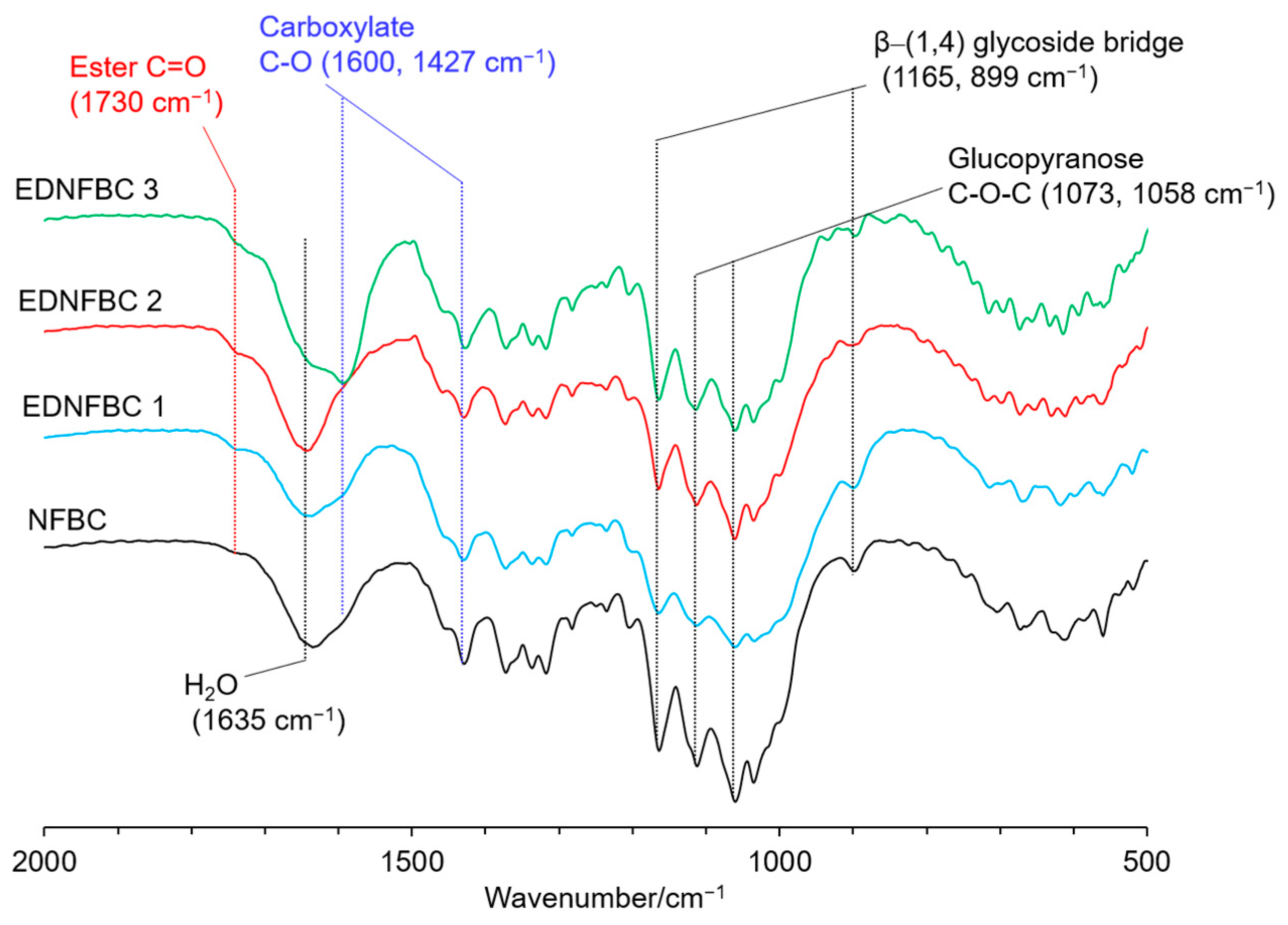
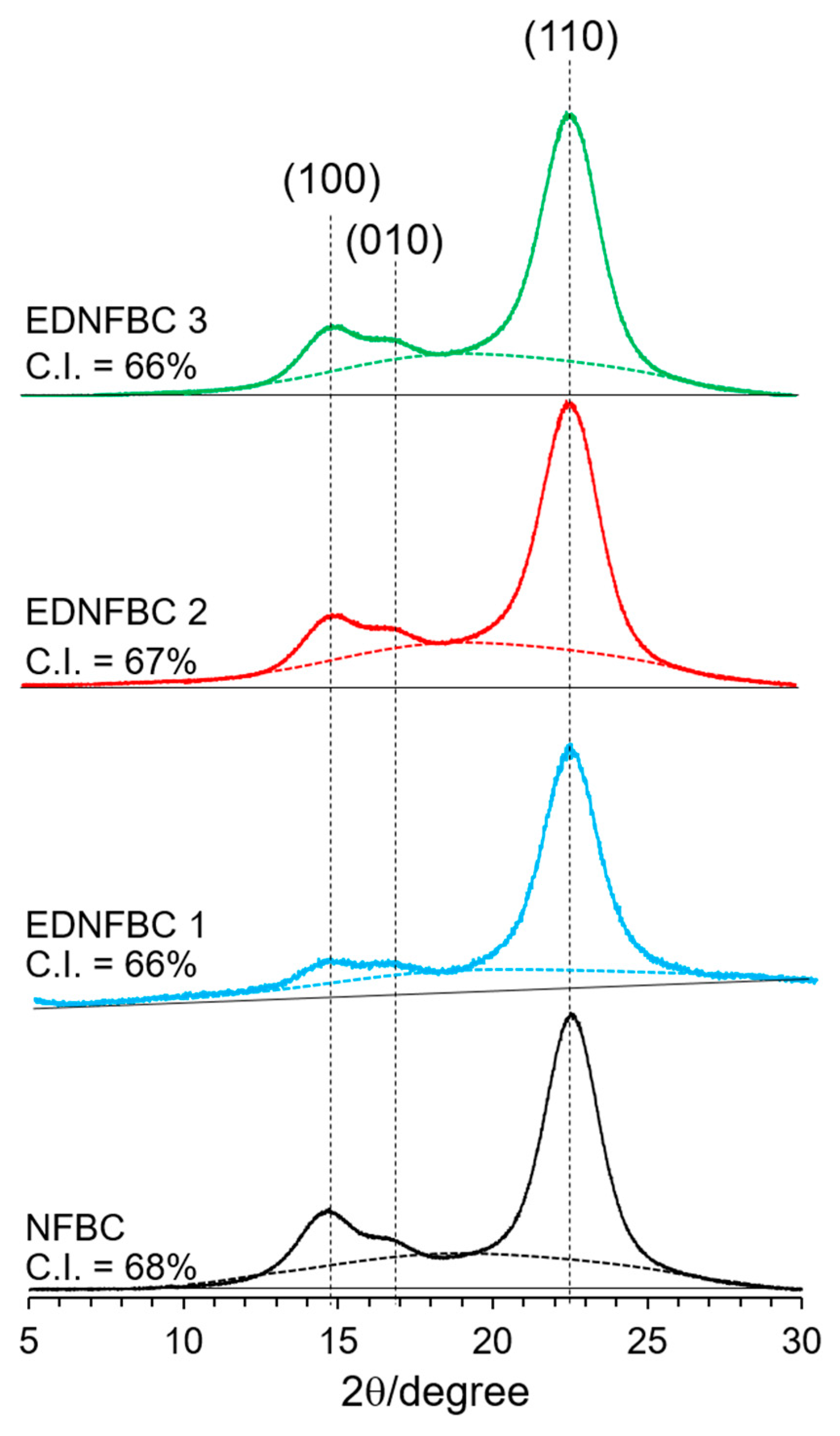
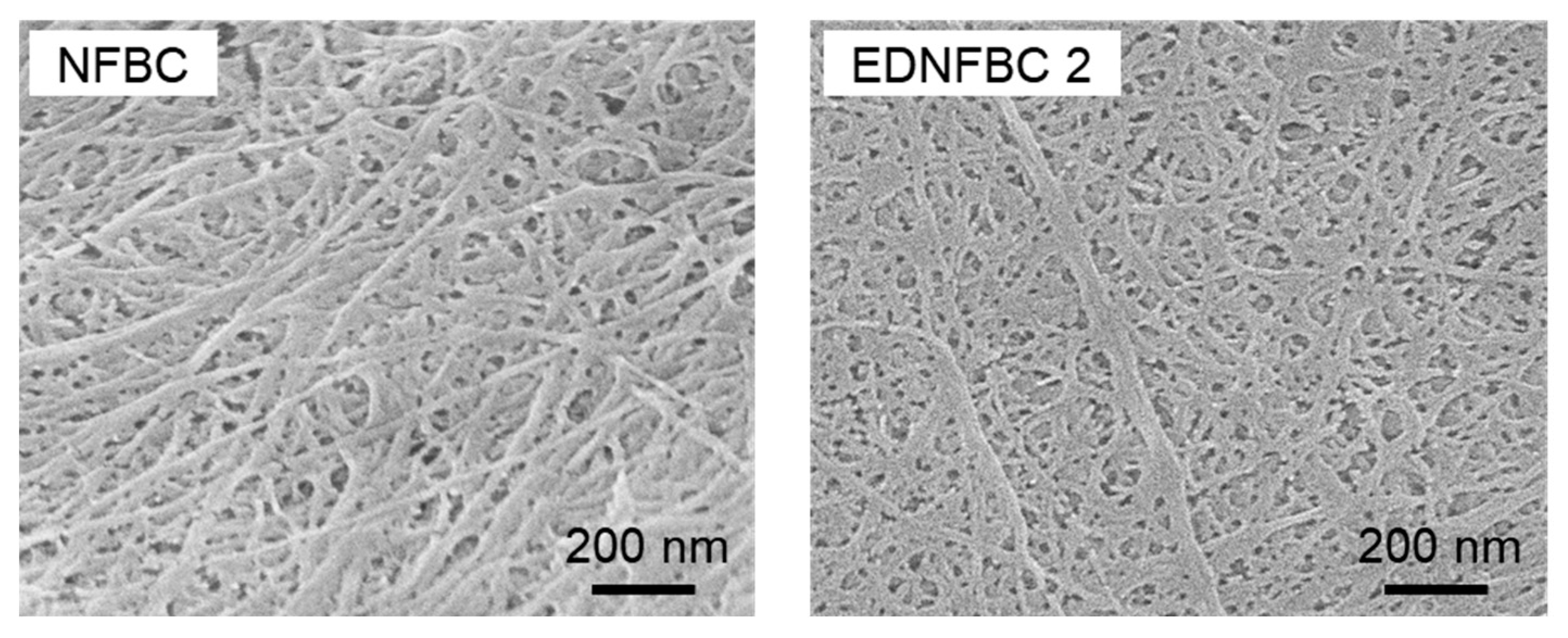


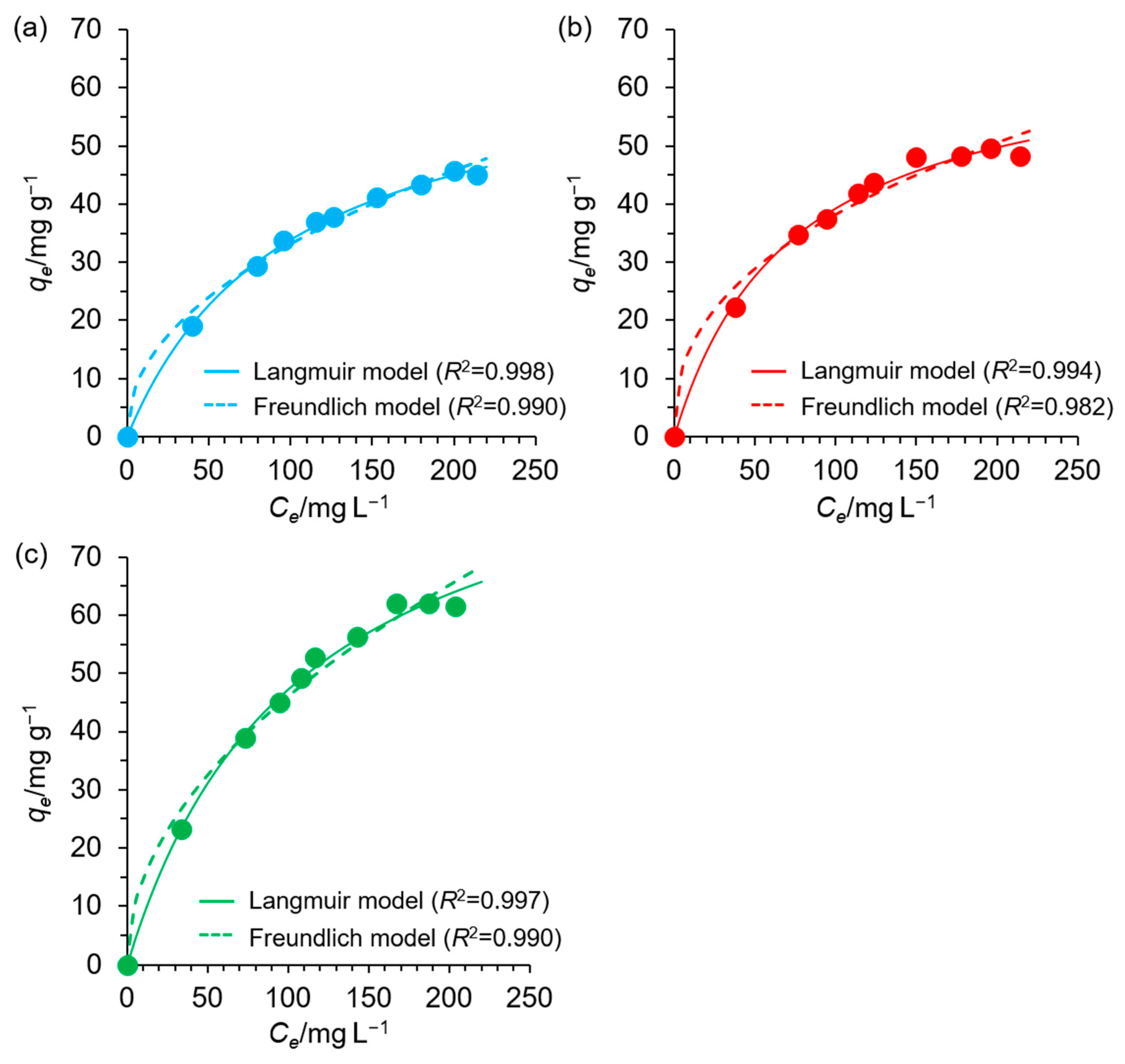
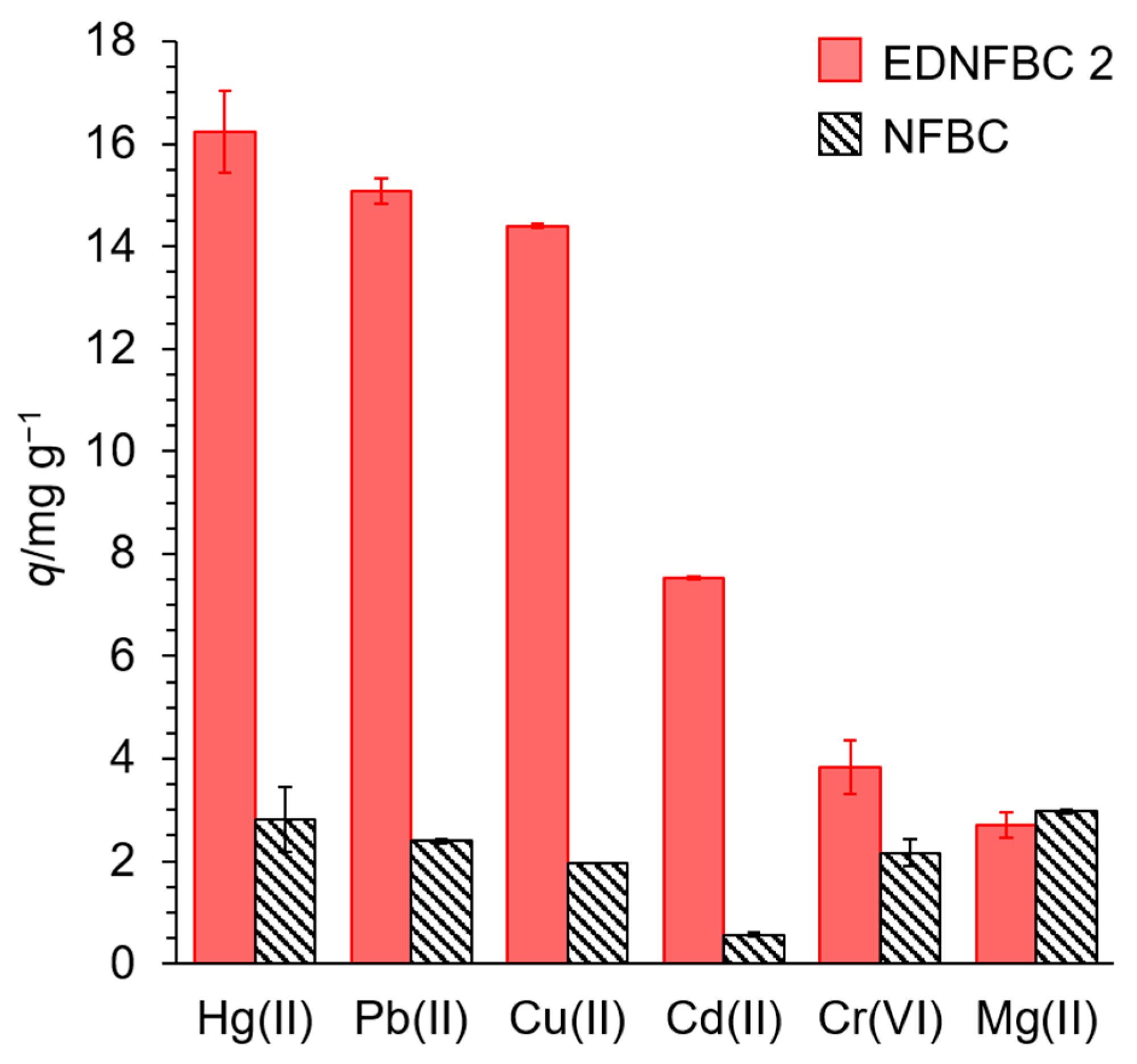

| Sample | Initial Feed Amount | Feed Molar Ratio of EDTAM/AGU | D.S. b | |
|---|---|---|---|---|
| NFBC (g) (AGU a (mmol)) | EDTAM (g) (mmol) | |||
| EDNFBC 1 | 1.00 (6.2) | 0.7 (3.1) | 0.5 | 0.25 |
| EDNFBC 2 | 1.00 (6.2) | 1.4 (6.2) | 1.0 | 0.33 |
| EDNFBC 3 | 1.00 (6.2) | 2.9(12.4) | 2.0 | 0.49 |
| Experimental qe (mg g−1) | 38.1 | |
| Pseudo-first-order model | k1 (min−1) | 0.13 |
| Calculated qe (mg g−1) | 36.1 | |
| R2 | 0.672 | |
| Pseudo-second-order model | k2 (g mg−1 min−1) | 0.0066 |
| Calculated qe (mg g−1) | 37.7 | |
| R2 | 0.940 | |
| Elovich model | α (mg g−1 min−1) | 1.02 × 104 |
| β (g mg−1) | 0.36 | |
| R2 | 0.915 | |
| EDNFBC | 1 | 2 | 3 | |
| Experimental qe (mg g−1) a | 45.1 | 48.3 | 61.6 | |
| Langmuir | Qm (mg g−1) | 67.2 | 78.6 | 97.3 |
| KL (L mg−1) | 0.010 | 0.010 | 0.0094 | |
| RL | 0.50–0.29 | 0.51–0.30 | 0.53–0.31 | |
| R2 | 0.998 | 0.982 | 0.997 | |
| Freundlich | n−1 | 0.467 | 0.406 | 0.503 |
| KF (L mg−1) | 3.84 | 5.89 | 4.55 | |
| R2 | 0.990 | 0.982 | 0.990 | |
| BET | QmBET (mg g−1) | 7.23 | 8.60 | 13.0 |
| Kb | 8.60 × 107 | 1.89 × 105 | 19.1 | |
| R2 | 0.871 | 0.876 | 0.951 | |
Disclaimer/Publisher’s Note: The statements, opinions and data contained in all publications are solely those of the individual author(s) and contributor(s) and not of MDPI and/or the editor(s). MDPI and/or the editor(s) disclaim responsibility for any injury to people or property resulting from any ideas, methods, instructions or products referred to in the content. |
© 2025 by the authors. Licensee MDPI, Basel, Switzerland. This article is an open access article distributed under the terms and conditions of the Creative Commons Attribution (CC BY) license (https://creativecommons.org/licenses/by/4.0/).
Share and Cite
Fujita, S.; Sasa, R.; Kinoshita, N.; Kishimoto, R.; Kono, H. Nano-Fibrillated Bacterial Cellulose Nanofiber Surface Modification with EDTA for the Effective Removal of Heavy Metal Ions in Aqueous Solutions. Materials 2025, 18, 374. https://doi.org/10.3390/ma18020374
Fujita S, Sasa R, Kinoshita N, Kishimoto R, Kono H. Nano-Fibrillated Bacterial Cellulose Nanofiber Surface Modification with EDTA for the Effective Removal of Heavy Metal Ions in Aqueous Solutions. Materials. 2025; 18(2):374. https://doi.org/10.3390/ma18020374
Chicago/Turabian StyleFujita, Sayaka, Ryosui Sasa, Nanami Kinoshita, Ryota Kishimoto, and Hiroyuki Kono. 2025. "Nano-Fibrillated Bacterial Cellulose Nanofiber Surface Modification with EDTA for the Effective Removal of Heavy Metal Ions in Aqueous Solutions" Materials 18, no. 2: 374. https://doi.org/10.3390/ma18020374
APA StyleFujita, S., Sasa, R., Kinoshita, N., Kishimoto, R., & Kono, H. (2025). Nano-Fibrillated Bacterial Cellulose Nanofiber Surface Modification with EDTA for the Effective Removal of Heavy Metal Ions in Aqueous Solutions. Materials, 18(2), 374. https://doi.org/10.3390/ma18020374






